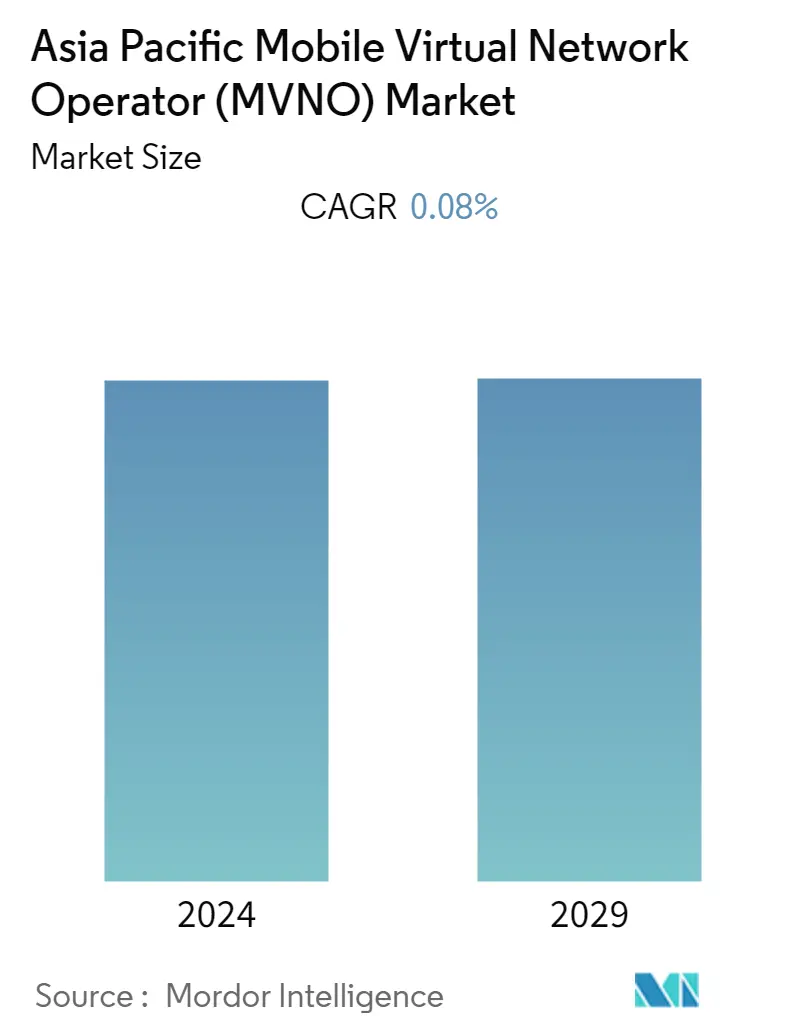Market Size of Asia Pacific Mobile Virtual Network Operator (MVNO) Industry

| Study Period | 2019 - 2029 |
| Base Year For Estimation | 2023 |
| Forecast Data Period | 2024 - 2029 |
| Historical Data Period | 2019 - 2022 |
| CAGR | 0.08 % |
| Market Concentration | Low |
Major Players_Market_comapny_logo.webp)
*Disclaimer: Major Players sorted in no particular order |
Need a report that reflects how COVID-19 has impacted this market and its growth?
Asia-Pacific MVNOs Market Analysis
The Asia-Pacific Mobile Virtual Network Operator (MVNO) Market size is expected to grow from USD 49.85 billion in 2023 to USD 50.05 billion by 2028, at a CAGR of 0.08% during the forecast period (2023-2028).
Wireless service providers, known as mobile virtual network operators (MVNOs), purchase network capacity from already-existing MNOs to provide services to customers.
- In an increasingly digital world and a fragmented telecommunications sector, MVNOs were expanding and bringing new value to consumers and established mobile network operators by utilizing innovative technology and exploring new verticals. E-Sim, AI, ML, and edge computing are new technological enablers that are giving MVNOs new opportunities.
- In developed countries, MVNOs are well-established, and as developing economies develop, their significance will rise. Due to MNOs' dominance in the low-cost cellular services industry in developed and developing nations, competition in the Asia-Pacific MVNO market has recently changed from pricing to value-added services and product differentiation. The development of 5G and IoT technology is increasing the expansion of the MVNO sector as a whole. For enterprises and mobile end users, current developments show a need for demand flexibility and a wider selection of services. In order to offer new services, MVNOs are utilizing the potential of 5G and IoT, two of the most disruptive technologies.
- Asian mobile markets are enormous and include a wide range of products. The mobile market environments of Japan, South Korea, China, Hong Kong, and the Association of Southeast Asian Nations (ASEAN) nations differ. In contrast to MVNOs, which have few assets tethered to the land, mobile network operators (MNOs), who are primarily domestic creatures, could not sustain this variance and diversity through their efforts.
- However, lack of prioritization, which means that during periods of high traffic, MVNOs would frequently see their data speeds slowed down as the main network operator (like T-Mobile) prioritizes the data speeds of its own customers. This could impede market expansion.
- The Asia-Pacific region is not an exception to how COVID-19 pushed the global digital transformation. The importance of the Internet has been brought to light by the quick development of online education and health services, e-commerce, and remote working. As a result, the APAC region's MVNO market is being driven by the resilient performance of the mobile industry, which has experienced flat growth in mobile subscribers and a minor decline in earnings.
